Best Electric Right Angle Drill — Buyers Guide, Top Pick, and Comparison
Compact yet remarkably versatile — the best electric right angle drill units access the areas other drivers cannot reach. Typically featuring relatively short snub head and chucks positioned at 90-degrees to the handle, these drills are ideal for close-quarter work where space is at a minimum — such as between drywall slats and beneath floorboards. Furthermore, with many models being smaller than their standard drill counterparts — they’re excellent for modest projects that don’t warrant a complete beast of a machine.
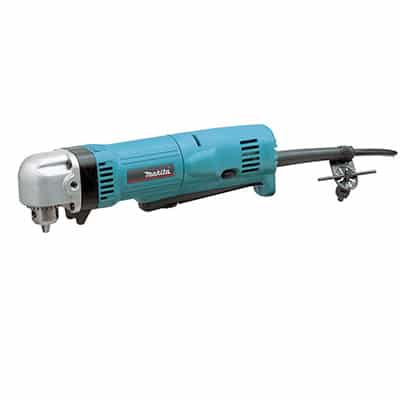
- Includes removable auxiliary handle.
- Speed-limiter to prevent over-tightening.
- Remarkably compact.
- 0.375-inch chuck.
- Shockproof.
Electric Right Angle Drill Comparison Table
| IMAGE | PRODUCT | DETAILS | ||
|---|---|---|---|---|
|
Best Reversible 
|
Best Reversible
|
Makita DA3010F
|
Features
|
Check Price at Amazon Makita DA3010F Review Makita DA3010F Review |
|
Best for DIYers 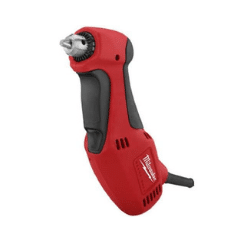
|
Best for DIYers
|
Milwaukee 0370-20
|
Features
|
Check Price at Amazon |
|
Best for Joists 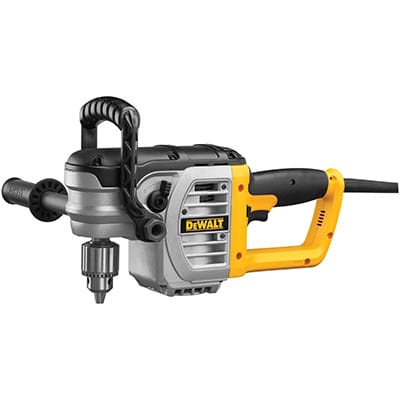
|
Best for Joists
|
DeWalt DWD460
|
Features
|
Check Price at Amazon DeWalt DWD460 Review DeWalt DWD460 Review |
|
Best for Power 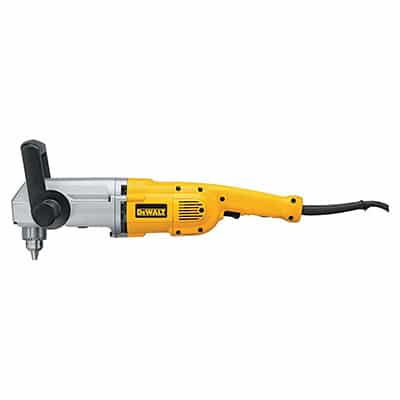
|
Best for Power
|
DeWalt DW124
|
Features
|
Check Price at Amazon DeWalt DW124 Review DeWalt DW124 Review |
|
Best Portable 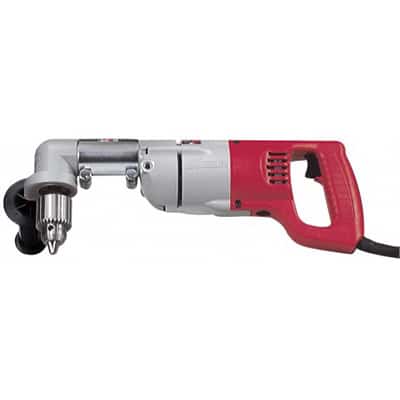
|
Best Portable
|
Milwaukee 3107-6
|
Features
|
Check Price at Amazon Milwaukee 3107-6 Review Milwaukee 3107-6 Review |
Best Electric Right Angle Drill Buying Guide
Hardcore drilling and driving often mean working in the most awkward of confined spaces — the best cable-powered electric right angle drill can relieve the headaches of close-quarter projects.
With a relatively compact build, 90-degree head, and often featuring one-handed operation — you can access the tightest of locations while still permitting accurate control and sufficient grunt delivery.
The corded models have the benefits of consistent power output and typically with more brawn than the cordless right-angle format. Although, if you’re looking for the ultimate in beast-like force — I suggest checking out the pneumatic 90-degree units instead.
When selecting the best corded right angle drill — consider:
-
- Cable length.
- Speed output.
- Torque delivery.
- Chuck diameter.
- Keyless or keyed.
- Handle formats.
- Size of the trigger.
- Additional accessories included with the unit.
Do You Need a Right-Angle Drill?
Should all your drilling projects involve nothing more complicated than driving into walls or masonry — you don’t need a 90-degree machine. Instead, check out our picks of the ultimate general application drills.
However, if your trade or DIY jobs stray slightly away from the norm — a corded right-angle machine can prove priceless. Compact and pleasingly flexible, these drills are ideal for work in tighter areas, especially in:
-
- Cabinet construction.
- Channeling timber for pipe or electrical cable access.
- Loft work — including rafter repair or attic conversion.
- Working between floor joists.
- Screwdriving/removal inside engine bays.
- Operating amid ceiling slats.
- Drilling inside cupboards.
- Projects that involve access to drywall interiors.
- Working beneath sinks.
- Locations where only one-handed access is possible.
- Addressing sub-decking joists.
Furthermore, typically smaller than a standard corded drill, these right-angle units offer a more portable and compact alternative.
How to Choose the Ultimate 90 Degree Electric Drill
Here are the key areas to consider when selecting your optimum electric angle drill:
Cord Length
While offering more consistent power than a cordless machine — cable-driven right-angle drills have the downside of mains tethering.
Hence, always consider the length of the cord when selecting your unit — I’d personally suggest a minimum of eight feet, as featured in the Milwaukee 0370-20. The longer the cable, the more operational freedom it provides — although too much snake-like length and it can become a hazard.
Naturally, you can utilize an extension cord — but always ensure that this auxiliary lead is compatible with the amperage of your drill.
Torque vs Speed
Typically, it’s a trade-off.
The more torque delivered by a corded 90-degree machine, i.e. its brawn, the lower the top speed — and vice versa.
Therefore, it’s crucial that you assess your typical project’s requirements.
Repetitive screwdriving or drilling jobs would benefit from a rapid unit — I’d recommend a model such as the Makita DA3010F that knocks out an incredible 2400 rpm. Conversely, work that involves boring into metals or dense hardwoods would necessitate a machine with some serious torque — for example, the DeWalt DW124.
Chuck Size
Typically, right-angle 90-degree corded drills feature either a 0.375-inch or 0.5-inch chuck.
The 0.375-inch format is ideal for most DIY and casual use driving projects — able to accommodate the most commonly utilized metal and wood bits, as well as screwdriving attachments.
Opting for the larger 0.5-inch chuck — as exemplified by the Milwaukee 3107-6 — permits the use of the wide diameter boring heads — crucial for trade work or extreme DIY.
Keyless or Keyed Chuck
If you’re an experienced DIYer — you know how easily tool accessories can become misplaced, lost, or disappear into the seemingly bottomless abyss of your toolbox.
The advantage of a keyless chuck on your corded right-angle machine is that there’s no key to lose — saving you valuable downtime hunting for this elusive component. However, bear in mind that these tool-free chucks aren’t as efficient at grabbing the bit — a factor that can be an issue when drilling into stubborn, dense materials.
Handle Format
I’d recommend seeking a unit that arrives complete with a detachable auxiliary handle — such as the Milwaukee 3107-6. This permits welcome additional control and pushing power — with the advantage of being removable to access confined spaces.
Furthermore, many machines — especially trade-grade drills like the DeWalt DWD460 — boast a rear-molded D-handle. This elevates gripping strength, enabling you to attack the densest of woods and metals.
Trigger Size
In the most awkward, confined drilling spaces — you can often find yourself operating the tool at arm’s length, one-handed, and at full stretch. This can make it challenging to keep the trigger sufficiently depressed — and can rapidly lead to finger or forearm fatigue.
Should this be a familiar scenario in your drilling projects, I’d suggest selecting a machine that features a substantial paddle trigger — for example, as featured on the Makita DA3010F.
Operated by four fingers, it makes continuous operation effortless while elevating stamina — permitting you to drill or drive longer and harder.
Additional Features and Accessories
While not deal-breakers, many 90-degree corded drills come complete with additional accessories or characteristics that may enhance your confined driving experience.
Bonus features to look out for include:
-
- Incorporated LED lamp for poorly-lit location work.
- A carry-case to protect your tool and increase portability.
- Speed limiter to prevent over-tightening or wood splitting.
- Mechanical clutch/brake to shield against gear damage.
- Gear oil.
- Warranty length.
Conclusion
For close-quarter work where operational space is limited — no other machine matches the versatility and flexibility of a mains-powered right-angled drill. Their 90-degree head and narrow build permit you to access the most awkward of areas — locations that would be impossible to reach with a standard corded machine.
Typically offering both one and two-handed operation — you can adjust your drilling style depending on whether you need additional pushing power or the ultimate in slimline use.
Admittedly, they’re project-specific. If your work involves addressing masonry, brickwork, or concrete — it would be more beneficial to check out the best hammer drills. What’s more, some users may find the mains lead tethering restrictive — in which case I suggest taking a look at our cordless 90-degree machines.
However, if you want stable power delivery combined with the ability to squeeze into the most challenging of spaces — get hold of an electric right angle drill.
Right-Angle Corded Drill FAQs
Q: What Is the Best Right-Angle 90-Degree Drill?
Delivering a seriously rapid 2400 rpm, including a removable secondary handle, and boasting an incorporated LED lamp — in my opinion, the ultimate corded right angle drill is the Makita DA3010F.
Q: What Trades Use Right Angle Drills?
Any project that involves drilling or driving in restricted space locations will benefit from a right-angle drill. As such, they are typically utilized by plumbers, carpenters, loft converters, cabinet makers, and automotive restorers.
Q: How Do You Use an Angled Drill?
Although straightforward in operation, a right angle drill requires using a slightly different technique to a standard corded model. Check out this video to discover the ideal way to wield a 90-degree machine:

Q: Can You Drill With Right Angle Attachment?
Yes. If you have minimal use for a 90-degree drill machine, it could be more cost-effective to purchase a right-angle attachment — which fits directly into your standard corded drill chuck.
However, bear in mind that this will make your already sizable drilling machine even more substantial — lacking the ideal compact snub build of a true right angle unit.
Q: When Would You Use a Right Angle Drill?
A 90-degree drill excels in tight space locations, such as inside cupboards, between joists, beneath floorboards, and inside floating ceilings.
Q: Can You Buy Cordless Right Angle Drills?
Yes. Cordless 90-degree drills offer greater operational freedom over their mains-tethered counterparts.
However, remember that they typically have a lower speed and/or torque output than corded machines — and naturally have limited running times of around 15-30 minutes.
Q: How Much Does a Right Angle Drill Cost?
You can obtain a quality 90-degree corded drill at a similar price point to a standard machine. However, prices can vary based upon:
-
- Torque and speed output.
- Manufacturer.
- Single or variable speed.
- Designed for trade or DIY use.
- The number of accessories — chuck, depth gauge, auxiliary handle, storage case.
- Palm grip or D-handle.
Q: Can You Get Right Angle Drill for Compressor?
Yes. In addition to mains-powered and cordless 90-degree machines, you can also obtain pneumatic right angle drills. These pro-grade tools are lightweight, although they naturally need access to a suitably rated compressor — which can make them awkward for portable use.
Q: What’s the Difference Between 90 Degree Drill and Right Angle Drill?
They’re exactly the same — just two different terms to describe the same confined space drilling tools.
